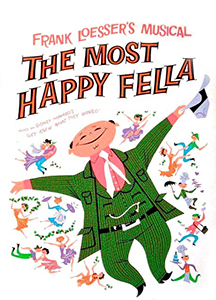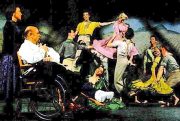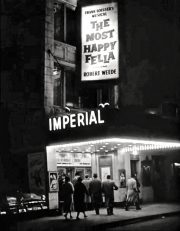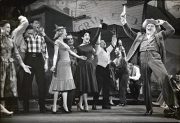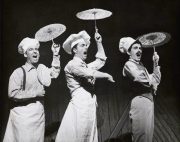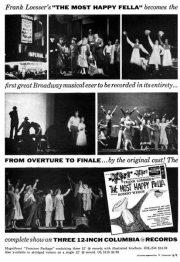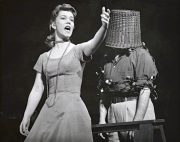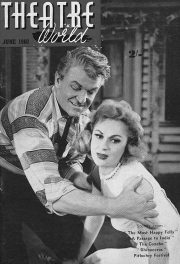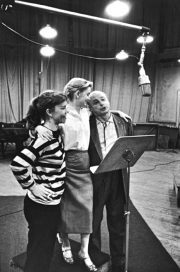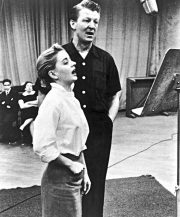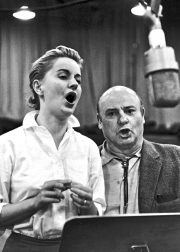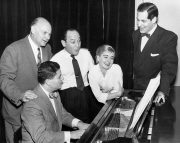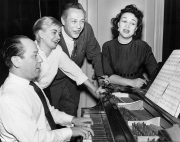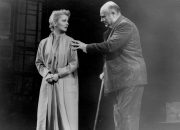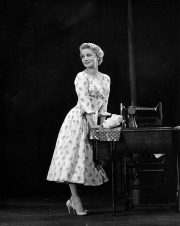Most Happy Fella, The
1956
Song List
“It is a masterpiece of our era…”
– Robert Coleman, Daily Mirror
History
Produced by Kermit Bloomgarden and Lynn Loesser (Frank’s wife of 20 years), “The Most Happy Fella” opened at the Imperial Theatre on Broadway on May 3, 1956, settling in for a run of 676 performances. Even in a season that gave us “My Fair Lady”, “Candide” and “Bells Are Ringing”, MHF was hailed as an extraordinary musical drama and a missing link between Broadway and opera. (Frank Loesser himself called it a musical comedy – “with a lotta music.”) The original cast included Metropolitan Opera baritone Robert Weede as Tony, Jo Sullivan (who Loesser later married) as Rosabella, popular band singer Art Lund as Joe, big-voiced Susan Johnson as Cleo, and country personality Shorty Long as Herman. In an unprecedented move, the score was recorded by Columbia Records in its entirety on three LP discs.
MHF was revived on Broadway in 1979 for 53 performances with Giorgio Tozzi as Tony. The 1991-92 season saw not only the smash Broadway revival of “Guys and Dolls”, but two major revivals of “The Most Happy Fella.” The first, a limited engagement by the New York City Opera at Lincoln Center, opened on September 4, 1991 and played 10 performances in repertory. Four months later, a duo-piano version, transferred from the Goodspeed Opera House in Connecticut to the Booth Theatre on Broadway and ran for 229 performances. That production, recorded on a single highlights disc by RCA, saw Spiro Malas as Tony, Sophie Hayden as Rosabella, Charles Pistone as Joe, Liz Larsen as Cleo, and Scott Waara, who won the Tony Award for his portrayal of Herman
Awards
Drama Critics’ Circle Award
Short Synopsis
Amy, a waitress in 1927 San Francisco, is wooed through letters by lonely middle-aged bachelor, Tony Esposito, from his vineyard in California’s Napa Valley. He proposes to Amy (who he calls “Rosabella”), enclosing a photograph of his handsome ranch hand, Joe, rather than one of himself. Despite this deception, Tony and Rosabella find love and, eventually, forgiveness and acceptance. Against this serious story is played the funny tale of Herman (Tony’s gentle-natured employee) and Cleo (Rosabella’s smart, tart-tongued friend), who play out a romance as playful as Tony and Rosabella’s is passionate and painful. All of this is set to one of the richest musical scores ever composed for the American theatre: a melodic and lyric triumph that is both worldly and wise to the ways of the heart.
Reviews
“Mr. Loesser loves the rich, rolling exhilarating cadences that can spill out into an auditorium whenever a musical show approaches the freedom and the melodic fury of opera… Mr. Loesser has simply opened his treasure chest and hurled the bountiful prizes…”
-Walter Kerr Herald Tribune
“An overwhelmingly inventive new musical, a rich show drenched in song.”
-William Hawkins, World-Telegram & Sun
“The Most Happy Fella enjoys a great diversity in the structure of its music. Loesser mixes pop and legit, arioso and recit, underscored dialogue: this is a demonstration piece of how many different techniques Broadway had developed for music theatre by 1956. If My Fair Lady hadn’t opened six weeks before, The Most Happy Fella would have been the official glory of the mid-1950s. There is only one greater score in this decade, that of Candide – and even Candide is not as emotionally elaborated as The Most Happy Fella”
-Ethan Mordden, COMING UP ROSES: THE BROADWAY MUSICAL IN THE 1950s (Oxford University Press, NY 1998)

